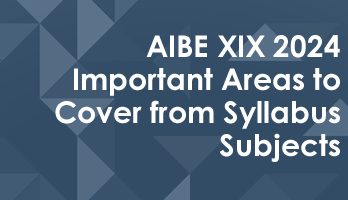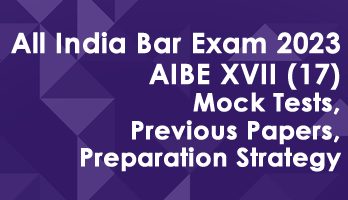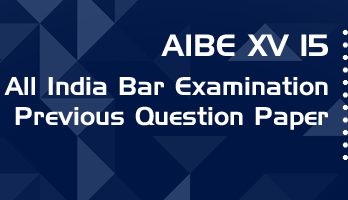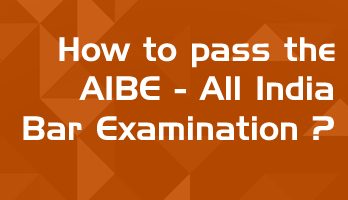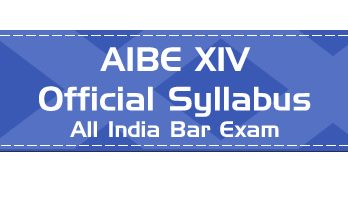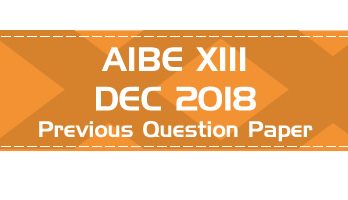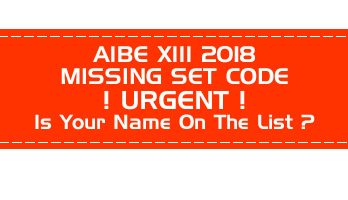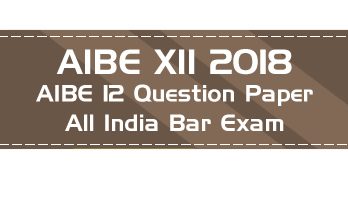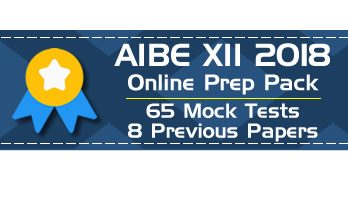- Updated as per the latest AIBE Syllabus & Pattern
- 15 AIBE Previous Question papers - AIBE IV to XVIII
- 15 Full-length mock tests as per latest pattern
- All Questions with Answers and Explanations
- Access valid for one year from date of purchase
- Accessible 24 x 7 via Smart-Phone, Tablets and Desktops
- Free Sample Mock Test - Try Before You Buy
Authentic Feedback from previous LawMint users :
I got AIR 21 in CLAT PG. Thank you so much. Your mocks helped me a lot in my preparation 🙂 - Ayushi Jain
I have subscribed to your CLAT PG program and got AIR 36 in this year CLAT PG. I have also secured AIR 54 in AILET PG exam. I would like to thank you. Your mock paper really helps a lot - Shrashank Tripathi
I would like to thank you for the CLAT PG LLM COURSE. Practising mock tests there helped me in getting confidence and hence I was able to get AIR 45 in CLAT PG LLM - Akshay Awasthi
A year back, I relied on the IIT Kharagpur RGSOIPL mock test series by LawMint to prepare for my RGSOIPL entrance test. Few months back, I relied on your UGC NET Law series to prepare for UGC NET. I was the topper of the RGSOIPL entrance, and have cracked JRF in UGC NET. All thanks to LawMint - Anshuman Sahoo
"I got AIR 18 in CLAT PG and General Category rank 28 in AILET PG. I want to thank you for helping me practice well in controlled conditions from any place. It gave me a lot of confidence and I took the tests while travelling too. I also made it to IIT Kharagpur." - Vinodharani
"Lawmint has been of great help to me in securing AIR 25 in AILET PG and AIR 29 in CLAT PG examinations. The subjective and objective approach of the test series kept me up to date with the latest exam pattern." - Bhawna Nanda
"I, Nimmy Saira Zachariah joined you clat test series. I cleared AILET PG with 30th rank. Your test series were of immense help as it gave me clear idea of where my preparations stand thank you once again law mint." - Nimmy S Z
"Hey guys. Where do I start? If I thought that getting AIR 59 in Clat PG was it, then how wrong I was. With Lawmint now I have cracked UGC NET as well." - Joyanta Chakraborty
In this article, I will talk about how to prepare for the All-India Bar Exam, why people fail in this exam and what are the best strategies you can follow during your preparation and also, the strategies to use when you attempt this exam.
What is the AIBE – The All India Bar Exam ?
First of all, what is the AIBE or the All-India Bar Exam?
As you are already aware, the AIBE is a mandatory qualifying exam, if you intend to practice as an advocate in India. When this exam started sometime in 2011, the format was somewhat different; and the AIBE 1, 2 and 3 question papers were never published.
The current format started from AIBE 4 onward; and all the previous papers are included as mock tests in the LawMint AIBE series.
This is a 100-marks – 100-MCQs – objective type exam. Currently, the exam duration is 3 hours or 180 minutes – During some previous years the exam used to be for 3 and half hours.
The syllabus for the AIBE is based on the standard LLB subjects. The Topic wise or the Subject wise weightage for the number of questions is published before the exam.
Currently, AIBE follows an open-book format – i.e. bare acts without any notes or explanations can be carried into the exam hall. Here again, there have been changes in the past – for some years the AIBE was a normal exam. No books were allowed. Then they said you can carry any books that you want to. Then they changed it to bare acts and handwritten notes only.
Currently the rule is that only bare acts, without any notes are allowed.
There is no negative marking in the AIBE for incorrect or unanswered questions.
This is a pass-fail exam – you don’t get any rank – whether you just pass the exam or score 100% – you get the same certificate of practice.
The minimum marks required to pass is 45% for General and OBC candidates and 40 percent for SC ST and PWD candidates. It used to be 40 and 35 earlier, which was later increased.
Looking at all of this, the AIBE should be a fairly simple exam to clear; especially when compared to other exams like the UGC NET, CLAT PG or Judicial services.
But the reality is something else.
How many people take the AIBE? What is the success rate?
In response to an RTI query, the BCI released the overall numbers for AIBE 18.
Out of the 144014 candidates who appeared for the exam, only 69646 passed. 74368 students failed in the exam.
Which means that only around 48.36% cleared the AIBE and 51.64% of the candidates failed.
If the exam is fairly simple, who do more than 50% of the candidates fail in this bar exam?
Here are the numbers from AIBE XVIII – AIBE 18, which was conducted in 2023.
| Registered | 148781 |
| Appeared | 144014 |
| Absent | 4767 |
| Pass | 69646 |
| Fail | 74368 |
Why do candidates fail in the AIBE?
There are five main reasons as to why more than 50% of the candidates fail in the bar exam.
The first one is overconfidence – candidates assume that because the AIBE is an open book exam. It will be easy to pass!
Then there is lack of preparation and practice – either because candidates genuinely don’t have enough time to prepare – due to work pressure or personal commitments. Or the lack of preparation may be intentional – because of overconfidence.
Then there are candidates who put in the effort to prepare – but they are following the wrong preparation strategy.
And then there are candidates who fail because they do not use a proper strategy while taking the exam – and this is attributable to lack of practice.
And finally, students don’t make themselves comfortable with using physical printed books for reference.
These days we just use soft-copies or PDF documents – so we lose touch with using physical documents – so practicing with printed material is also very important.
In fact, even a couple of years ago I had made a video about the AIBE and mentioned then also that many candidates seem to take the AIBE very lightly.
Unlike other exams, which you may decide to skip, you don’t have a choice with the AIBE. If you wish to practice law, you have to clear the exam sometime or the other.
With a little bit of effort, you can clear it in your first attempt itself – especially since you will have to spend around 3500 rupees as exam fees for every attempt.
When should you take the AIBE – Bar Exam?
Before we discuss in detail the reasons for failing in the bar exam, let me first answer one very important question that I have been asked quite a few times. – Should I take the bar exam now?
You may not be planning to practice immediately. You may be preparing for other exams. You may have plans for pursuing other career opportunities.
My sincere advice is that if you intend to practice law anytime in the near future; and you have the opportunity to take the bar exam now, do it.
In fact, I would strongly recommend that you should take the bar exam as soon as you graduate. Especially if you are preparing for LLM entrance, UGC NET or judicial service exams – because this preparation will help in those exams as well.
The more time that elapses after your graduation, the more effort you will have to put in for your bar exam preparation.
“From 1/4th negative marking to limiting the validity of Bar exam for three years; SC issues notice to BCI to respond to suggestions.” – SCConline.com March 28, 2022
“BCI asks centres of legal education to implement three new criminal laws from 2024-2025 session.” – The New Indian Express, 23 May 2024
Over the past couple of years, you will have seen that various PILs have been filed about the bar exam – and it is very likely that sometime in the near future there may be changes in the exam – such as introduction of negative marking, making it a closed book exam etc.
And also, the LLB syllabus itself will change, which means that you will have to prepare are per the new syllabus – so, my suggestion is to take the bar exam as soon as possible after your graduation.
Overconfidence – The main reason why candidates fail in the AIBE.
Coming back to the reasons why candidates fail in the bar exam. The first and the main reason is overconfidence.
AIBE is an open book exam – so candidates assume that it is a very easy exam to pass.
First of all, you are allowed to carry only copies of the bare acts – without any notes. And if you check through the recent previous papers, you will see that all the questions will not be from within the books that you can open.
And going through the recent papers will show that out of the 100 MCQs, just around 60 are direct questions from the bare acts. 14 – 15 are interpretation questions – which can be answered by interpreting the bare acts. And 24 – 25 are external or case law-based questions – which cannot be answered by using the bare acts alone.
Also, physical documents don’t have search or control ‘F’. Candidates end up wasting a lot of time in tying to find the answers – especially in lengthy documents like the CPC or the CRPC.
Not being comfortable with physical documents is another important reason for failure in this exam.
So, you need practice, to become comfortable with the structure and the layout of the physical copy of the bare act – so that you can quickly go to the relevant part and find the answers.
Examples of ‘Direct Questions’ in the All India Bar Exam
As I mentioned, though the AIBE is an open book exam, not all the answers will be within the books you can open. Only around 60 percent are direct questions.
These are some examples :
For what duration is a woman entitled to leave with wages for tubectomy operation as per the Maternity Benefit Act, 1961?
A) 2 weeks
B) 4 weeks
C) 6 weeks
D) 8 weeks
What should be the minimum number of workers originally employed in any factory for having at least one canteen in the factory as per the Factories Act, 1948?
A) 100 workers
B) 150 workers
C) 200 workers
D) 250 workers
Who among the following is not included in the definition of a workman as per the Industrial Disputes Act, 1947?
A) A supervisor drawing monthly salary of Rs.6,000.
B) A supervisor drawing monthly salary of Rs.8,000.
C) A supervisor drawing monthly salary of Rs.10,000.
D) A supervisor drawing monthly salary of Rs.12,000.
The acts are clearly mentioned in these – so you have to find the relevant sections – and you will be able to answer these questions.
Examples of ‘Interpretation Questions’ in the All India Bar Exam
Then there are interpretation questions, where you will have to read the question – read the information within the bare acts and do a little interpretation to identify the correct answers.
For example, this question is about when was this limit removed from section 125.
Question : The maximum limit of Rs. 500 that could be paid to the wife as maintenance under Section 125 of the Cr.P.C 1973 was removed in:
a) 1973
b) 1989
c) 2001
d) 2007
Section 125 does not mention any limits because it has been removed. But when you read through the section in the bare act, you will see that some words have been deleted. And the foot note says that certain words were omitted in 2001.
So, you can safely assume that the words that were removed in 2001 should be regarding these limits – because there is no mention of any other omissions.
This is another example :
Which of the following Amendment Act made the provision in the Code of Civil Procedure 1908 to produce a witness without a summons?
A) The Code of Civil Procedure (Amendment) Act, 1976
B) The Code of Civil Procedure (Amendment) Act, 1999
C) The Code of Civil Procedure (Amendment) Act, 2002
D) Such provision does not exist.
It is asking about which amendment act made this provision. If you practice and become familiar with the CPC, including the orders and the rules, you will see that there is such a provision – so option D can be eliminated.
The footnote in the bare act says that this rule came into effect in 1977.
Which means that 1999 and 2002, which are later amendments, can be eliminated and 1976 has to be the correct answer.
Examples of ‘Illustration Based Questions’ in the All India Bar Exam
These are some questions based on the illustrations or the examples given under some sections. In some cases, they will just make some minor changes like A into X and Z into Y.
A and Z agree to fence with each other for amusement. In the course of such fencing, while playing fairly, A hurts Z severely. Which of the following offence is committed by A?
A) Hurt
B) Attempt to murder
C) Grievous hurt
D) No offence
X intentionally pulls up a woman’s veil without her consent intending to annoy her. As per the Indian Penal Code, 1860 which of the following offence he has committed?
A) Hurt
B) Criminal force
C) Assault
D) Grievous hurt
Since the section numbers are not mentioned in these questions, you will have to identify the relevant section – find the illustration – and you can answer these questions.
Examples of ‘External Questions’ in the All India Bar Exam
These are examples of completely external questions – they can be answered through general legal awareness
or if you remember the theory being discussed during your LL. B classes.
Who has defined tort as ‘tortious liability arises from the breach of duty primarily fixed by law; this duty is towards persons generally and its breach is redressible by an action for unliquidated damages’?
A) Lindsell
B) Pollock
C) Salmond
D) Winfield
Gloucester Grammar School case relates to which of the following important maxims?
A) Damnum sine injuria
B) Injuria sine damno
C) Ubi jus ibi remedium
D) Volenti non fit injuria
Examples of ‘Landmark Judgement Based Questions’ in the All India Bar Exam
These are some more external questions, which are based on landmark cases.
Which of the following is the landmark judgment on the Colourable legislation?
A) State of Bihar v Kameshwar Singh
B) M. Karunanidhi v Union of India
C) State of Karnataka v Union of India
D) Keshavan Madhava Menon v State of Bombay
In which of the following cases it was held that there could be no reservation on a single post in the cadre?
A) Chakradhar Paswan v State of Bihar
B) K.C. Vasanth Kumar v State of Karnataka
C) A.B.S.K. Sangh (Rly) v Union of India
D) State of Kerala v N.M. Thomas
Typically, these cases would have been included in your LL. B syllabus.
Which is also the reason why I recommend taking the bar exam as soon as possible after your LLB graduation.
Because the theory and the case laws are still relatively fresh in your memory.
Preparation time required for the All India Bar Examination
If you have decided to take the bar exam, what is the ideal preparation time that will be required?
In the LawMint AIBE Mock Test & Previous Papers series, we have provided all the 15 previous question papers – which add up to 1500 questions.
These 15 papers are in the form of mock tests + there are 15 more mock tests based on these questions.
The order of the questions and the answer options are randomly shuffled in every attempt for better practice.
And all questions have explanations included – to tell you which act or which section has the correct answer.
If you solve and clear all these previous papers and all the 15 mocks, you should be able comfortably pass the AIBE.
And this practice will also help in your CLAT PG, other LLM entrance exams, UGC NET or Judicial exams.
To solve these 15 + 15 mocks – you can ideally prepare for the bar exam in two months – if you can spare around 4 hours per day.
If you are preparing full-time – around 8 hours per day – you can complete these 15 + 15 mocks in one month.
If for some reason you have to do a crash preparation – you can even prepare in 15 days – as long as you can solve at least 2 question papers or mocks per day and complete all 30.
If it has already been two years or more since your LLB graduation, you should add another 15 days to these timelines, because you will take some time to pick up speed.
Solving all the previous papers is an absolute must – because the practice will make you familiar with the bare acts – you will be able to quick figure out which act, which section has the answer.
Practice will also help you decide the order in which to answer questions – for example, if you realize that you are more familiar with family law and company law questions, you can answer all of them first, before answering questions from other acts.
You will also see that a lot of questions are repeated from previous years – sometimes they are exactly same, and sometimes there are very similar – with a few minor changes.
And most importantly, solving all the previous papers and the mocks using physical bare acts, in exam conditions will make you comfortable in finding the answers without using the search function.
Let me also add that the LawMint series can be accessed on mobile devices or on laptops or desktops.
So, you can practice anywhere – and as I mentioned, explanations like this are included for better clarity on the correct answer.
There is also a free demo mock test that you can try, before you buy.
AIBE Exam Taking Strategies
When you go into the exam hall and start taking the bar exam, what are the strategies that you can use?
First of all, you should remember that your objective here is to pass the exam. There is no rank, there is no need to score very high marks.
If you answer 45 questions correctly – you will clear the bar exam. Add another 20 questions as a margin of safety. Which means that you should target to answer 65 questions correctly.
Rather than trying to answer all 100 questions within the 180 minutes and making lots of mistakes under pressure, your first priority should be to answer just 65 questions correctly.
This approach will give you more time per question + you can take the exam with less tension.
After you have answered 65 questions correctly, you can go back to the questions you have skipped – and attempt another 15 questions or so.
You can either find the correct answer or use elimination or guess work to identity the best answer.
And remember, there is no negative marking – so, in the last 10 minutes, answer all the remaining questions – even if you just have to guess or just select a random answer.
Since time management is very important in this exam, this approach will help you a lot.
By focusing on the 65 target questions, you will get more time per question.
Answer all the direct questions and the interpretation questions first; and then you can spend time in answering the external questions.
Practicing all the previous papers will tell you which approach works best for you.
Why Previous Question Papers are very important in your AIBE preparation
Practicing all the previous papers and the mock tests will also help you decide what is the order in which to answer the questions.
It can be based on the weight given to specific acts – so constitution first, CRPC and CPC next.
It can also be on the basis of your familiarity with the acts – if you are more familiar with CPC and family law, you can answer all CPC questions first and then family law questions and then the other acts.
You can also consider the size and complexity of the acts to decide the order. IPC and Evidence act, both will have 8 questions each. But evidence act is a shorter and a less complex act – so you can answer evidence act questions first.
Practice with the previous papers and the actual physical bare act books will help you decide which is the best order for you.
Which Bare Act books to buy for the AIBE?
Which brings us to the question, which books to buy?
Practically speaking, you will use these books only for this exam, after which you are not likely to use them again.
So, don’t spend too much on buying the most expensive books. You will get a good set of bare act books within around 1500 rupees.
There are plenty of options available on both FlipKart and Amazon. The prices on amazon seem to be more reasonable – so compare both websites before you decide.
Remember, the bare acts are same for all publishers – it is only the quality of the paper and the size of the print that will be different.
So, check both websites, check the user reviews and compare the prices.
I would recommend separate booklets for each rather than the consolidated versions. The separate booklets are easier to use.
Since footnotes are also useful in answering the questions, the footnotes should be included in the bare acts that you purchase.
And if you know any seniors who took the bar exam recently, ask them for the books, even if they are one or two years old, they are good enough for this exam.
Check out the LawMint AIBE Previous Question Papers & Mock Tests Series :
- Updated as per the latest AIBE Syllabus & Pattern
- 15 AIBE Previous Question papers - AIBE IV to XVIII
- 15 Full-length mock tests as per latest pattern
- All Questions with Answers and Explanations
- Access valid for one year from date of purchase
- Accessible 24 x 7 via Smart-Phone, Tablets and Desktops
- Free Sample Mock Test - Try Before You Buy
Authentic Feedback from previous LawMint users :
I got AIR 21 in CLAT PG. Thank you so much. Your mocks helped me a lot in my preparation 🙂 - Ayushi Jain
I have subscribed to your CLAT PG program and got AIR 36 in this year CLAT PG. I have also secured AIR 54 in AILET PG exam. I would like to thank you. Your mock paper really helps a lot - Shrashank Tripathi
I would like to thank you for the CLAT PG LLM COURSE. Practising mock tests there helped me in getting confidence and hence I was able to get AIR 45 in CLAT PG LLM - Akshay Awasthi
A year back, I relied on the IIT Kharagpur RGSOIPL mock test series by LawMint to prepare for my RGSOIPL entrance test. Few months back, I relied on your UGC NET Law series to prepare for UGC NET. I was the topper of the RGSOIPL entrance, and have cracked JRF in UGC NET. All thanks to LawMint - Anshuman Sahoo
"I got AIR 18 in CLAT PG and General Category rank 28 in AILET PG. I want to thank you for helping me practice well in controlled conditions from any place. It gave me a lot of confidence and I took the tests while travelling too. I also made it to IIT Kharagpur." - Vinodharani
"Lawmint has been of great help to me in securing AIR 25 in AILET PG and AIR 29 in CLAT PG examinations. The subjective and objective approach of the test series kept me up to date with the latest exam pattern." - Bhawna Nanda
"I, Nimmy Saira Zachariah joined you clat test series. I cleared AILET PG with 30th rank. Your test series were of immense help as it gave me clear idea of where my preparations stand thank you once again law mint." - Nimmy S Z
"Hey guys. Where do I start? If I thought that getting AIR 59 in Clat PG was it, then how wrong I was. With Lawmint now I have cracked UGC NET as well." - Joyanta Chakraborty


